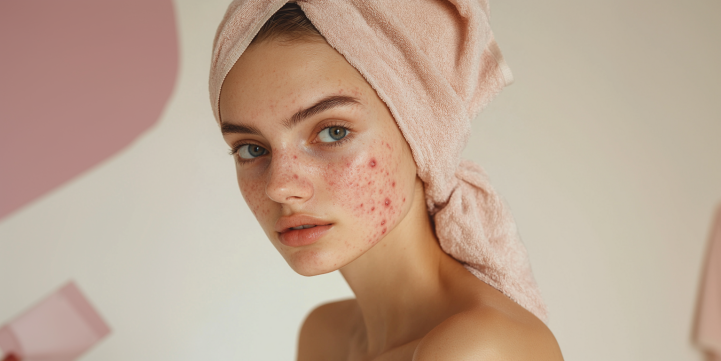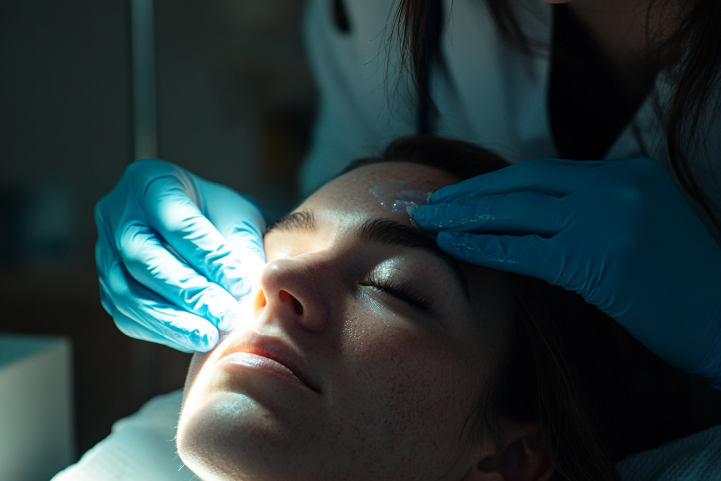Epidemiology of Acne
Acne is one of the most common skin conditions worldwide, affecting about 9.4% of the population, making it the eighth most prevalent disease globally. In countries like China, its prevalence can range dramatically, from 8.1% to 85.1%. This wide variation suggests that acne can affect individuals differently based on several factors. Additionally, 3% to 7% of acne sufferers may develop scarring, highlighting its long-term impact. While it primarily affects adolescents, with up to 100% of them experiencing it, acne can persist into adulthood, particularly in women. Interestingly, around 42% of pregnant women develop acne during pregnancy, with 60% of these cases worsening during this time.
Pathogenesis of Acne
Acne is a chronic inflammatory skin condition triggered by multiple factors. The primary cause is an overproduction of sebum (skin oil), often due to androgens (male hormones) that stimulate the sebaceous glands. Alongside this, abnormal skin cell turnover and clogged pores create a breeding ground for Propionibacterium acnes (P. acnes), a bacteria that contributes to inflammation and acne. A disrupted skin microbiome and immune responses also play key roles in acne development.
Types of Acne
Acne can vary in severity, ranging from mild to severe, and the treatment approach depends on the extent of the condition. In its mildest form (Grade 1), acne presents with comedones, which are blackheads and whiteheads. In moderate cases (Grade 2), comedones are accompanied by inflammatory papules, which are red, swollen bumps on the skin. More severe forms (Grade 3) involve comedones, papules, and pustules, which are pus-filled lesions. In the most severe cases (Grade 4), acne can include comedones, papules, pustules, cysts, and may result in scarring.
The diagnosis of acne is typically made through clinical examination, with the presence of open and closed comedones, papules, pustules, and cysts being key indicators. In more severe cases, acne can lead to ulcers and scarring. It is crucial to differentiate acne from other skin conditions such as rosacea, seborrheic dermatitis, or bacterial infections, which may share similar symptoms but require different treatments.

Treatment for Acne
The treatment of acne involves medical interventions and skincare adjustments. Depending on the severity, options include topical treatments, oral medications, physical therapies, and sometimes traditional remedies.
Topical treatments for acne include several options that can help reduce inflammation and manage the condition. Retinoids, which are Vitamin A derivatives, are effective in reducing inflammation and preventing clogged pores. Benzoyl peroxide is another common treatment that kills acne-causing bacteria and helps reduce inflammation. Antibiotics, either topical or oral, such as clindamycin or tetracycline, are often used to reduce bacterial growth. Azelaic acid is beneficial for reducing irritation and lightening scars, while salicylic acid, a beta-hydroxy acid, helps unclog pores and reduce inflammation.
For moderate to severe acne, oral treatments are often recommended. Oral antibiotics like doxycycline and minocycline are used to control bacterial growth and inflammation. For more severe cases, oral retinoids like isotretinoin may be prescribed, which help reduce sebum production and prevent new acne lesions. Hormonal therapy can also be effective, especially for women, with birth control pills or anti-androgens like spironolactone helping to regulate hormones and reduce acne symptoms.

In addition to medication, physical therapy is also a good option for those who prefer non-drug treatments. Photodynamic therapy (PDT) uses specific wavelengths of light to target acne-causing bacteria, helping to reduce lesions. Chemical peels use acids to exfoliate the skin, which can clear clogged pores and improve the overall appearance of the skin. ZQ-II Oil-Control Acne Treatment Set can also be combined with mesotherapy to better treat this condition. Laser treatments, such as intense pulsed light (IPL) and fractional laser, can also effectively reduce acne scars and improve skin texture, providing a way to treat active acne and its sequelae.
Skincare for Acne-Prone Skin
Alongside medical treatments, adopting the right skincare routine is essential for managing acne:
Gentle Cleansing: Use a mild cleanser twice a day to remove oil and impurities without over-drying.
Exfoliation: Exfoliate regularly with products like ZQ-II Salicylic Acid Oil-Control Mask to prevent clogged pores.
Hydration: Use non-comedogenic moisturizers like ZQ-II Skin Barrier Repairing Gel to keep the skin hydrated without triggering breakouts.
Sun Protection: Sunscreen is vital to prevent scarring and further skin damage from UV rays. ZQ-II Sunblock Cream with a powerful Broad Spectrum UVA/UVB SPF50+++ coverage is an ideal option.
Acne is a multifactorial skin condition that can be effectively managed with the right combination of medical treatments, physical therapies, and skincare routines. With the proper care and timely intervention, patients can experience significant improvements in their skin and self-esteem.


